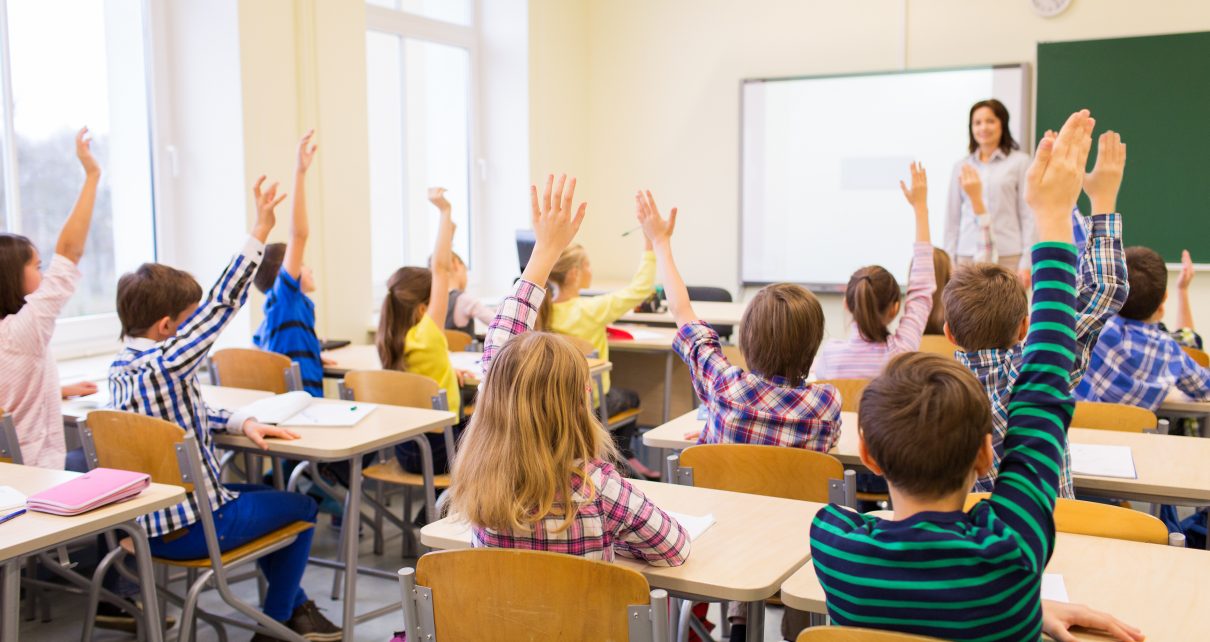
Kids in a classroom. (Photo: Shutterstock/Syda Productions)
California Public School Enrollment Drops by Another 110,000 Students – Fifth Decline in a Row
Lawmakers and teachers unions propose making kindergarten mandatory to increase number of students
By Katy Grimes, April 15, 2022 7:47 am
Across California, state figures showed that K-12 enrollment fell by 160,000 students in 2020, which was a 3-percent dip and the largest drop in enrollment in twenty years, the Globe reported last fall in October.
The Los Angeles Times is now reporting that California public school enrollment has declined by more than 110,000 students in 2021 — “as K-12 campuses struggle against pandemic disruptions and a shrinking population of school-age kids amid wide concerns that the decrease is so large that educators can’t account for the missing children.”
In the Los Angeles Unified School District, enrollment dropped by 27,000 students last year, which was a nearly 6 percent fall. The Los Angeles Times noted at that time that this percentage decline “is three times what planners in the nation’s second-largest school district predicted.”
Even more ominous for the future of the regular public schools is the plunge in enrollment among the nation’s youngest students.
Perhaps predictably, California lawmakers and their teachers union bosses propose making Kindergarten mandatory to increase their inventory of billable students.
EdSource reported:
“State Sen. Susan Rubio, D-Baldwin Park, is championing a bill to make kindergarten mandatory while Assemblymember Kevin McCarty, D-Sacramento, has introduced legislation that would require school districts to offer full-day kindergarten. While both proposals have been put forth before, if these two pieces of legislation pass, they would fundamentally redefine and expand key aspects of the kindergarten experience.”
EdSource even doubled down on propaganda:
“Making kindergarten mandatory will help close the state’s achievement gap, advocates say, because some children who skip kindergarten have a hard time catching up with their peers. Children from low-income families enter school with fewer academic skills than their more advantaged classmates, an issue heightened by the pandemic.”
This is patently false. Lance Izumi, Director of Education Studies at the Pacific Research Institute said in January about the governor’s proposal to significantly expand early childhood programs, “research from other states wave warning flags. A Vanderbilt University study of Tennessee’s pre-kindergarten program found participants scored lower on tests and had greater discipline problems than students not in the program. The study concluded that the results ‘offer a cautionary tale about expecting too much from state pre-K programs.’ That’s a warning that California should consider seriously.”
Notably, Izumi also told the Globe children in Finland beat students in the U.S. in math, reading and science, even though Finnish children don’t start school until age 7.
The LATimes blames the pandemic for the enrollment losses, despite the five-years of enrollment losses:
“While public school enrollment has experienced a downward trend since 2014-15, state education officials largely blamed the pandemic for the plummeting numbers over the last two years. This year’s decline, which includes charter schools, follows a huge enrollment hit during the 2020-21 school year, when the state experienced the largest drop in 20 years, with 160,000 students. In March 2020 the pandemic closed campuses in California and across the country, forcing schools into distance learning, many for nearly a year.”
Izumi said the pandemic and subsequent school lockdowns is responsible for huge learning losses among American children:
“According to the McKinsey researchers, students, on average, fell behind five months in math and four months in reading by the end of the 2021 school year. More troubling, the researchers found that the pandemic had widened achievement gaps between student demographic groups.”
“In math, students in schools with majority African-American populations ended the year with six months of unfinished learning, while students in low-income schools suffered a learning loss of seven months. Further, the study found, ‘High schoolers have become more likely to drop out of school and high school seniors, especially those from low-income families, are less likely to go on to postsecondary education.’”
Parents realized they had education choice during the pandemic. According to statistics released by the California Department of Education in 2021, home schooling in California continued to grow during the 2020-2021 school year, reaching record levels of students learning from home, the Globe reported. The number of new home schooling affidavits filed by parents with the California DOE has nearly tripled in the last few years, going from 14,548 in the 2018-2019 school year, to 22,433 in 2019-2020 and 34,715 in 2020-2021. A further 3,215 affidavits for private schools with 6 or more students were also filed in 2020-2021, another large increase from previous years.
Charter schools have been such a threat to the teachers unions that in 2020 and again in 2021, the Governor and Legislature sought to defund public charters, and prevent more from opening. The defunding was in California budget Senate Bill 98, and in AB 1316, authored by Assembly education committee chair Patrick O’Donnell (D-Long Beach), and supported by the California Teachers Association, which deals with spending on K-12 education, and denies funding for students newly enrolling in a public school.
Izumi says during the pandemic, chronic absenteeism in California rose dramatically. Chronic absenteeism is defined as students missing 10 percent or more of school days.
“In Stockton, about four out of 10 of students were chronically absent in the 2020-21 school year—more than double the rate two years ago.
Among elementary school students in Oakland, 37 percent were chronically absent, more than two and a half times the rate two years ago.
And even in suburban Elk Grove, in Sacramento County, a quarter of students are chronically absent, which is three times the rate two years ago. The state and school districts have sought to hide their failures by changing rules so that students can graduate with fewer units. In some districts you can graduate with about half of the units normally required. Also, districts are actually eliminating handing out failing grades to students.”
Izumi said Oakland has limited D’s and F’s. So has Los Angeles and other districts. One Oakland teacher said, “Not reporting D’s and F’s is the equivalent of lying about a student’s progress.”
And the California Department of Education doesn’t track the number of students who graduate with fewer units, Izumi said.
With this record, who would want to hand over their kindergartener to the state classrooms?
- Leaving California: Three More Major Businesses Close or Move Out of State - December 22, 2025
- Gov. Gavin Newsom’s ‘Great Leap Forward’ – DEI and Reparations Agriculture Land Seizure Scheme - December 22, 2025
- AG Bonta Promotes California’s ‘Migrant Community’ Over California Citizens - December 20, 2025





California educational system for years, has not been about the student.
It has been about the teachers’ egos.
Comrades
Some realized we have enough ball cap and apron workers, so some kids are actually being educated for jobs of the future-